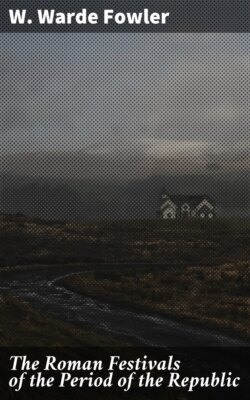Читать книгу The Roman Festivals of the Period of the Republic - W. Warde Fowler - Страница 33
На сайте Литреса книга снята с продажи.
VII Kal. Mai. (April 25). NP.
ОглавлениеTable of Contents
[ROB]IGALIA. (CAER. ESQ. MAFF. PRAEN.)
Note in Praen: FERIAE ROBIGO VIA CLAUDIA AD MILLIARIUM V NE ROBIGO FRUMENTIS NOCEAT. SACRIFICIUM ET LUDI CURSORIBUS MAIORIBUS MINORIBUSQUE FIUNT. FESTUS EST PUERORUM LENONIORUM, QUIA PROXIMUS SUPERIOR MERETRICUM EST.
Robigo means red rust or mildew which attacks cereals when the ear is beginning to be formed[309], and which is better known and more dreaded on the continent than with us. This destructive disease is not caused by the sun’s heat, as Pliny[310] tells us was the notion of some Italians, but by damp acting in conjunction with a certain height of temperature, as Pliny himself in fact explains it.
Robigus[311] is the spirit who works in the mildew; and it has been conjectured that he was a form or indigitation of Mars[312], since Tertullian tells us that ‘Marti et Robigini Numa ludos instituit’[313]. This is quite consistent with all we know of the Mars of the farm-worship, who is invoked to avert evil simply because he can be the creator of it[314]. The same feature is found in the worship of Apollo, who had at Rhodes the cult-title ἐρυθίβιος[315], or Apollo of the blight, as elsewhere he is Apollo Smintheus, i.e. the power that can bring and also avert the pest of field-mice.
Robigus had a grove of his own at the fifth milestone on the Via Claudia; and Ovid relates in pretty verses how, as he was returning from Nomentum (doubtless by way of his own gardens, which were at the junction of the Via Claudia with the Via Flaminia near the Milvian bridge[316]), he met the Flamen Quirinalis with the exta of a dog and a sheep to offer to the god[317]. He joined the procession, which was apparently something quite new to him, and witnessed the ceremony, noting the meri patera, the turis acerra, and the rough linen napkin[318], at the priest’s right hand. He versified the prayer which he heard, and which is not unlike that which Cato directs the husbandman to address to Mars in the lustration of the farm[319]:
Aspera Robigo, parcas Cerialibus herbis,
Et tremat in summa leve cacumen humo.
Tu sata sideribus caeli nutrita secundi
Crescere, dum fiant falcibus apta, sinas.
Parce, precor, scabrasque manus a messibus aufer,
Neve noce cultis: posse nocere sat est, &c.
Ovid then asked the flamen why a dog—nova victima—was sacrificed, and was told that the dangerous Dog-star was in the ascendant[320]:
Est Canis, Icarium dicunt, quo sidere moto
Tosta sitit tellus, praecipiturque seges.
Pro cane sidereo canis hic imponitur arae,
Et quare pereat, nil nisi nomen habet.
In this, however, both he and the priest were certainly mistaken. Sirius does not rise, but disappears on April 25, at sunset; and it is almost certain that the sacrifice of the dog had nothing to do with the star. The real meaning of the choice of victim was unknown both to priest and poet: but modern research has made a reasonable attempt to recover it[321].
We are told[322] of a sacrifice of reddish sucking whelps, and of augury made from their exta, which must have been closely connected with the Robigalia, if not (in later times at least) identified with it. Originally it was not on a fixed day, as is proved by an extract from the commentarii pontificum quoted by Pliny[323]; but it is quite possible that for convenience, as the religio of the urbs got more and more dissociated from the agriculture in which it had its origin, the date was fixed for April 25—the rites of the Robigalia being of the same kind, and the date suitable. The whelps were red or reddish; and from the language of Festus, quoting Ateius Capito, we gather that this colour was supposed to resemble that of the corn when ripe: ‘Rufae canes immolabantur, ut fruges flavescentes ad maturitatem perducerentur’ (p. 285). We should indeed naturally have expected that the rufous colour was thought to resemble the red mildew, as Mannhardt explains it[324]; but we do not know for certain that these puppies were offered to Robigus. In any case, however, we may perhaps see in them an animal representation of the corn, and in the rite a piece of ‘sympathetic magic’[325], the object of which was to bring the corn to its golden perfection, or to keep off the robigo, or both. If we knew more about the dog-offering at the grove of Robigus, we might find that it too, if not indeed identical with the augurium, had a similar intention.
The red mildew was at times so terrible a scourge that the Robigalia must in early Rome, when the population lived on the corn grown near the city, have been a festival of very real meaning. But later on it became obscured, and gave way to the races mentioned in the note in the Praenestine calendar[326], and under the later empire to the Christian litania maior, the original object of which was also the safety of the crops[327]. The 25th is at present St. Mark’s day.
